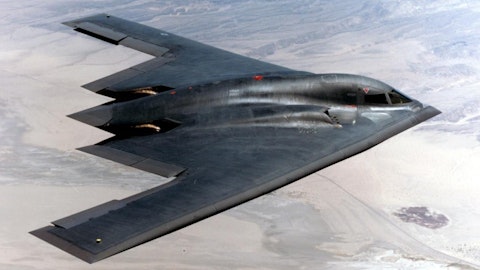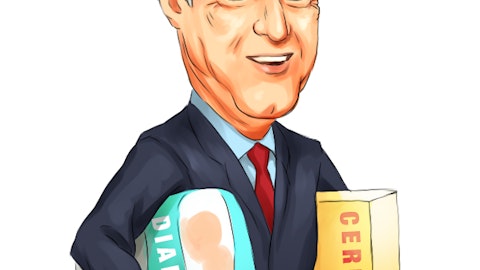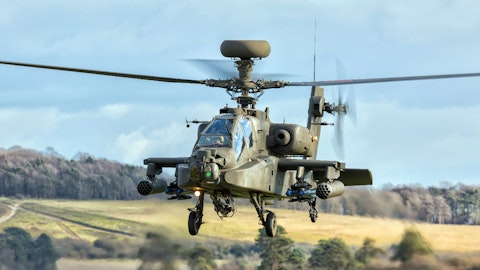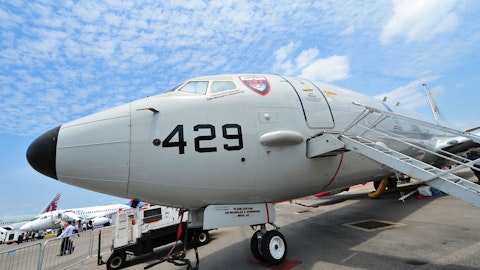Textron Inc. (NYSE:TXT) Q1 2024 Earnings Call Transcript April 25, 2024
Textron Inc. misses on earnings expectations. Reported EPS is $ EPS, expectations were $1.28. Textron Inc. isn’t one of the 30 most popular stocks among hedge funds at the end of the third quarter (see the details here).
Operator: Welcome to the Textron First Quarter 2024 Earnings Call. At this time, all participants are in a listen-only mode. Later, we will conduct a question-and-answer session. [Operator Instructions] This conference is being recorded for digitized replay and will be available after 10 a.m. Eastern Time today through April 25 of 2025. You may access the replay by dialing (866) 207-1041 and enter the access code 8546032. I would now like to turn the conference over to David Rosenberg, Vice President, Investor Relations. Please go ahead.
David Rosenberg: Thanks, Liah, and good morning, everyone. Before we begin, I’d like to mention we will be discussing future estimates and expectations during our call today. These forward-looking statements are subject to various risk factors, which are detailed in our SEC filings and also in today’s press release. On the call today, we have Scott Donnelly, Textron’s Chairman and CEO; and Frank Connor, our Chief Financial Officer. Our earnings call presentation can be found in the investor relations section of our website. Revenue in the quarter were $3.1 billion, up from $3 billion in last year’s first quarter. Segment profit in the quarter was $290 million, up $31 million from the first quarter of 2023. During this year’s first quarter, adjusted income from continuing operations was $1.20 per share, compared to $1.05 per share in last year’s first quarter.

Manufacturing cash flow before pension contributions reflected a use of cash of $81 million in the quarter, compared to $104 million of cash provided in last year’s first quarter. With that, I’ll turn the call over to Scott.
Scott Donnelly: Thanks, David, and good morning, everyone. In the first quarter, we saw a higher segment profit at Aviation, Bell and Systems. At Aviation in the quarter, we delivered 36 jets, up from 35 last year, 20 commercial turboprops down from 34 last year’s first quarter. Aviation continues to see strong demand across our product lines. The result in backlog growth of $177 million, and in the first quarter $7.3 billion. Textron aviation’s fleet utilization remains strong in the quarter, contributing to aftermarket revenue growth of 6%, as compared to last year’s first quarter. Throughout Q1, we saw continued improvements in our supply chain and hours attained in the factory, supporting delivery growth throughout the remainder of the year.
At Bell, revenues in the quarter were up, driven by higher military volume, reflecting the continued ramp of the FLRAA program. On the FLRAA program, we continue to progress through preliminary design reviews and expect to complete milestone B, which allows for the entrance into the engineering and manufacturing development phase of the program later this summer. Also during the quarter, Bell received an award for the production and delivery to Nigeria of 12 AH1Z helicopters. For V22, the recently enacted FY ‘24 budget includes five additional aircraft scheduled for delivery in 2027. On the commercial side of Bell, we delivered 18 helicopters down from 22 in last year’s first quarter. During the quarter, we continued to progress toward FAA certification on the 525, expected later this year.
See also 25 Best Countries for Expats With Low Taxes and High Quality of Life and 20 Countries That Increased Oil Production the Most in A Decade.
Q&A Session
Follow Textron Inc (NYSE:TXT)
Follow Textron Inc (NYSE:TXT)
Bell recently received its first order for 10 525 helicopters from Equinor, a Norwegian state energy company. Moving to Textron systems, revenue was flat, and margin was up versus last year’s first quarter. During the quarter, we received notification from our government customer of the termination of the Shadow program. We’re currently working with the Army on winding this program down. This decision reflects the Army’s transition from Shadow to the future tactical UAS system to fulfill the need of organic intelligence, surveillance, and reconnaissance. Earlier this month, we received notification that we were awarded options three and four of the EQAS program, and we remain one of two competitors for this next generation program. Also in the quarter, Systems was down selected with one other competitor to design, develop, and manufacture a 30 millimeter autocannon advanced reconnaissance vehicle prototype for the U.S. Marine Corps.
This two year effort will develop an innovative combat vehicle that provides mobile protective firepower for the Marines. In addition, the Army’s FY ‘25 budget request funds the design of the XM-30 ground combat vehicle in preparation for the prototype build and testing portion of Phases 3 and 4 in the program’s development. Moving to industrial, we saw lower revenues in the quarter, largely driven by lower volume and mix in the specialized vehicles. Caltech’s revenues were flat in the quarter. We’re encouraged by recent trends in the hybrid space where industry is experiencing increased customer demand and new OEM investments in hybrid platforms. At aviation, Pipistrel delivered 30 aircraft in the quarter, up from 13 in 2023. Also during the quarter, Pipistrel was granted an airworthiness exemption by the FAA for its Velis Electro Trainer, which will allow U.S. flight schools to use this all-electric aircraft in their pilot training programs.
With that, I’ll turn the call over to Frank.
Frank Connor: Thanks, Scott, and good morning, everyone. Let’s review how each of the segments contributed, starting with Textron Aviation. Revenues at Textron Aviation of $1.2 billion were up $39 million from the first quarter of 2023, reflecting higher pricing of $48 million and lower volume and mix of $9 million. Segment profit was $143 million in the first quarter, up $18 million from a year ago, reflecting a favorable impact from pricing net of inflation up $14 million. Backlog in the segment ended the quarter at $7.3 billion. Moving to Bell, revenues were $727 million, up $106 million from last year’s first quarter, reflecting higher military volume than $95 million, primarily related to the FLRAA program. This was partially offset by lower volume on the V-22 and H-1 programs.
Segment profit of $80 million was up $20 million from a year ago, primarily driven by a favorable impact from performance of $30 million, which includes $13 million of lower research and development costs. Backlog in the segment ended the quarter at $4.5 billion. At Textron Systems, revenues were $306 million with last year’s first quarter. Segment profit was $38 million, up $4 million from last year’s first quarter. Backlog in the segment ended the quarter at $1.8 billion. Industrial revenues were $892 million, down $40 million from last year’s first quarter, largely reflecting lower volume and mix of $51 million, principally in the specialized vehicles product line, partially offset by higher pricing of $16 million in the segment. Segment profit of $29 million was down $12 million from the first quarter of 2023, primarily due to lower volume and mix at specialized vehicles.
Textron E-Aviation segment revenues were $7 million and segment loss was $18 million in the first quarter of 2024, compared with a segment loss of $9 million in the first quarter of 2024, primarily related to higher research and development costs. Finance segment revenues were $15 million and profit was $18 million. Moving below segment profit, corporate expenses were $62 million, net interest expense was $15 million, LIFO inventory provision was $20 million, intangible asset amortization was $8 million, and the non-service component of pension and post-retirement income was $66 million. In the first quarter of 2024, we incurred $14 million in special charges under the 2023 restructuring plan, largely related to headcount reductions to improve the cost structures of the Textron Systems and Bell Segments in light of the cancellations of the shadow and FLRAA programs in the quarter.
We expect to incur additional severance costs in the second quarter in the range of $25 million to $30 million, largely related to headcount reductions in the industrial segment. As a result, Textron has expanded its 2023 restructuring plan from a previously announced range of $115 million to $135 million in pre-tax special charges to a range of $165 million to $170 million. In the quarter, we repurchased approximately 3.6 million shares, returning $317 million in cash to shareholders. To wrap up with guidance, we are reiterating our expected full-year adjusted earnings per share to be in a range of $6.20 to $6.40 per share. We also expect full-year manufacturing cash flow before pension contributions of $900 million to $1 billion. That concludes our prepared remarks.
So Liah we can open the line for questions.
Operator: Thank you. [Operator Instructions] And we’ll start with David Strauss with Barclays. Please go ahead.
David Strauss: Thanks. Good morning, everyone.
Scott Donnelly: Good morning, David.
David Strauss: Scott, maybe if you could just dig into a little bit on the deliveries in the quarter. I think the mix was pretty strong, but relatively flat year-over-year, and you build a lot of inventory. So maybe just, you know, how the supply chain is doing. Did you want to deliver more airplanes than you ended up doing? And, you know, how did we think about how much deliveries could grow this year off of 168 last year? Thanks.
Scott Donnelly: Sure. I think that we certainly expect to see nice growth on a year-over-year basis. The supply chain does continue to improve the number of hours that we’re able to get in the factory in terms of labor hours that are productive hours. You know, post-training and whatnot does continue to improve. So I think we feel pretty good about how things progressed through the quarter. What we always have a few aircraft that we would like to have gotten delivered. We definitely had some things that got late in the corner, it just didn’t get to where they could transfer in time. But for sure the trend in terms of productivity and efficiency and throughput in the factory improved as we worked our way through the quarter. So a little bit lighter than we probably would have liked, but not a big number.
And I think, again, the momentum is good. And we certainly are still feeling very good about our guide in terms of, you know, a nice increase in volume on a year-over-year basis.
David Strauss: Great. Thanks very much.
Scott Donnelly: Sure.
Operator: Next, we go to the line of Robert Stallard with Vertical Research. Please go ahead.
Robert Stallard: Thanks so much. Good morning.
Scott Donnelly: Good morning.
Robert Stallard: Scott, maybe we’ll start with industrial. A bit of softness there in Q1. I know this is a tough division to forecast given its short-cycle nature, but are we finally seeing the U.S. consumer rolling over here?
Scott Donnelly: Well, I think we talked last year, Robert, towards the end of the year, and in our guide, you know, that we expected to see the high-end consumer dollars, recreational, personal transportation stuff soften. And we’re seeing that. It’s probably even a little bit softer than we would have expected. The automotive segment is pretty stable, which is fine. There are certainly some pieces in the vehicle business that are doing fine, but those high dollar discretionary items have certainly softened. As you know, those are often financed. Finance costs are certainly higher than they have been. So we expected it to be softer. Our PTV business, which has been a great business for us, was a little bit softer than we would have expected. And that’s part of what we want to do, some additional restructuring on top of our initial plan to dial that in and avoid a situation where we put too much inventory out in the field.
Robert Stallard: Right. And then maybe one for Frank. On the revised restructuring plan, do you — how do you expect the cash impact of that to flow through? And do you expect the savings to be roughly equivalent to the restructuring charge?
Frank Connor: Yes, I think the savings will be ultimately in the area of $185 million or so on a run rate basis. And we’ll realize a fair amount of that by the end of 2024, but that will roll into 2025 as well. The incremental cash is about $20 million in ‘24 for the additional restructuring, and we’ll just absorb that into our cash guidance. And overall cash for the restructuring for ‘24 is in the area $60 million to $65 million. So but additional $20 million versus where we had been.
Robert Stallard: Okay. That’s great. Thanks, Frank.
Operator: Next, we move on to Sheila Kahyaoglu with Jefferies. Please go ahead.
Sheila Kahyaoglu: Thank you. Good morning, Scott, Frank, and David. Can we start off with maybe Bell? Scott, if we look at margins, they expanded up 130 basis points at Bell to 11%, despite maybe $180 million of FLRAA contribution on the top line. So how do we think about the moving pieces to profitability for the year to get to $9.5 to $10.5?
Scott Donnelly: Well, I think we’ll probably still end up in that range, Sheila, we had a strong Q1, obviously, we did have, as we noted there, a settlement on an initial property-related lawsuit that gave us a little bit of a boost in the quarter. But I would say the team is performing well. You know, as you know, we did restructuring actions to try to deal with the loss of the FLRAA program. We were able, you know, in a number of cases to take some of the appropriate engineering talent and move that over to the FLRAA program, which helps ramp that program up. But we also had to take some cost actions, you know, both as a result of the loss of the FLRAA program, as well as some of the lower production quantities. Obviously, it will certainly help us as we start to see some flow of the Nigerian H1 order.
That gets that line back up and going again. The extra five on V-22, which is above the original program record, is certainly a nice add. And we’ll start to see some of that flow through in the latter part of the year. So I think Bell had a strong quarter. We’re continuing to focus very much on cost to deal with the mix issues there. But we’ll clearly end up towards the high side of guidance on Bell. I think they’re performing well.
Sheila Kahyaoglu: Great and then if I could ask one on Aviation, orders held up pretty well, book-to-bill above 1 time. Maybe if you could provide any color on what you’re seeing from your customers? One of your competitors noted interest rates are potentially prohibiting orders, if you could just comment on that?
Scott Donnelly: You know, Sheila, we continue to see real good strength across pretty much all the product lines in the business. So we’re feeling pretty good about the order flow. A lot of these aircraft are going to deliver a couple years from now. So from a financing standpoint, I don’t know, we don’t, [Indiscernible] as much about that, but the order activity was staying pretty strong. So positive.
Sheila Kahyaoglu: Great. Thank you.
Scott Donnelly: Sure.
Operator: Next, we go to Myles Walton with Wolfe Research. Please, go ahead.
Myles Walton: Thanks. Scott, I was wondering if you could touch on the supply chain within Bell. Obviously, the 1Q seasonally light usually for the commercial kilos, but down year-on-year. And then also the comment you made on the 525 certification at year-end, I know that one of your business heads had been quoted as getting more confident on that into the year end. Could you also comment on your confidence level of that certification? Thanks.
Scott Donnelly: Sure. Look, the Bell supply chain continues to, I would say, improve. We always have a number of parts that are our sort of, problem children. We’re continuing to work that. But in general, I think we are able to manage our way through that. And I don’t think there’s anything new or surprising that would in any way affect our guide as we think about Bell commercial volumes through the course of the year. We did have a very strong Q4, obviously, on the commercial deliveries. And so, you know, a little lighter maybe than we expected Q1, but I think we’re in good shape. And order activity there also remains, you know, very healthy. So I think Bell’s in a good place. 525 flight test is going very well. The FAA flight testing, you know, portion, we’re well into that.
We have a few more performance flight tests. And then we go through sort of what they call FNR, which is about 150 hours of just durability, reliability, flying. And obviously, as you guys know, we’ve been flying that aircraft for a long time. It’s proven to be a very durable, reliable aircraft, so I don’t think we’ll have any issues going through there. So we’ll — we should wrap up flight testing here as we get to mid-year and you know as you know there’s a fair bit of paperwork processing and you know final documents and all that kind of stuff have to go before the final certification. But I’d say at this point we feel pretty good about where it is.
Myles Walton: And if it were certified, what would be sort of the production rate that you’d target over the next few years?
Scott Donnelly: Yes, we haven’t released a production rate on the 525.
Myles Walton: All right. Thank you.
Scott Donnelly: Sure.
Operator: And our next question comes from Peter Arment with Baird. Please go ahead.
Peter Arment: Yes, good morning, Scott and Frank.
Scott Donnelly: Good morning, Peter.
Peter Arment: Hey, Scott, nice results. Did you quantify what the settlement was in the Bell that affected the margins this quarter?
Scott Donnelly: No, we didn’t. I mean, it’s not a huge number, Peter, but it’s enough that it helped the margin rate a little bit in the quarter.
Peter Arment: Okay, okay. I just wanted to clarify that. And then just a quick one, Frank. We expected that you would have higher corporate expenses in Q1. Just wondering, just from a modeling perspective, calibrate the rest of the street. Are we thinking more evenly spread for the balance of the year for your $160 million target?
Scott Donnelly: Yes, as you know, that bounces around depending on where the share price is, but kind of we expected it, it certainly will not be as volatile or may not be as volatile for the rest of the year. So we’ll see. But yes, we’re still sticking with the same target for the full-year.
Peter Arment: I appreciate it. Thanks, guys.
Operator: Next, we have a question from Cai von Rumohr with TD Cowen. Please go ahead.
Cai von Rumohr: Yes. So your competitors, Gulfstream and Embraer, basically had higher bizjet deliveries and were kind of closer to where they expected to be and yet you guys continue to struggle. Is part of that related to geography that you guys are in Wichita and you have to fight with spirit to get people, because they’re trying to ramp too and that therefore this is going to be a longer slog than maybe others are going to see?





